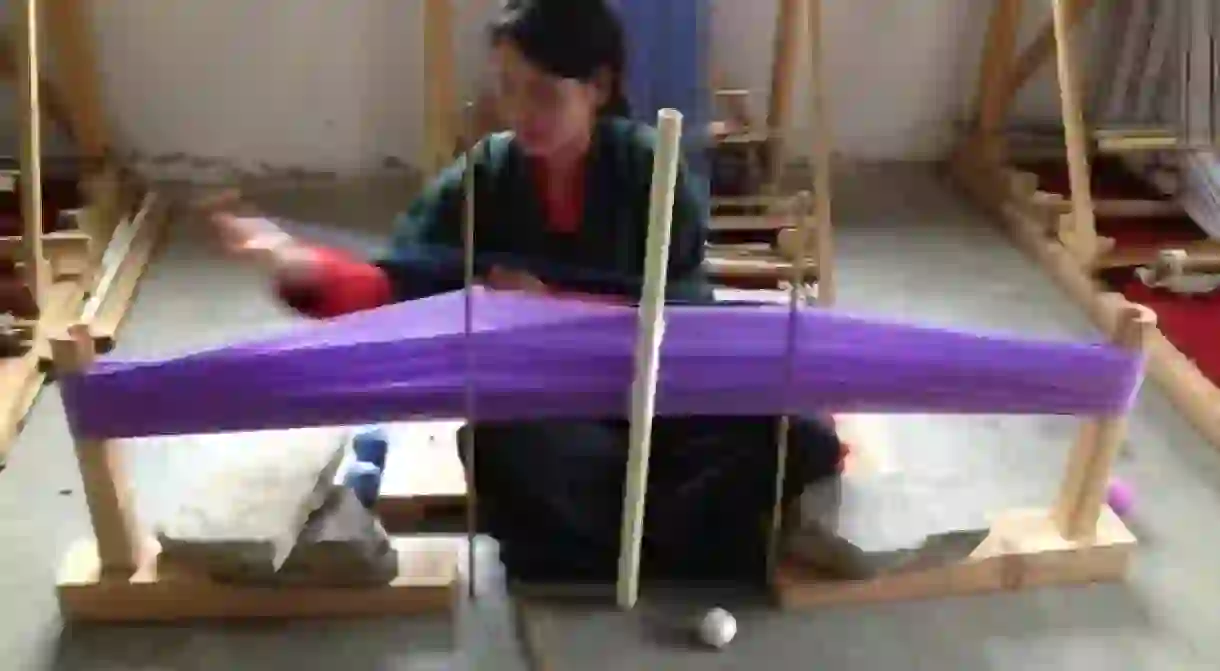Keeping Tradition Alive: Choki Traditional Art School In Bhutan’s Kabesa

Bhutan’s secluded nature means it has one of the most unique cultural traditions in the world. However this distinctiveness is under threat from globalization and efforts are being made to preserve cultural traditions through education, such as in the Choki Traditional Art School, where students learn traditional artistic crafts.

The cultural tradition of Bhutan is rich, distinctive and centuries old. Because the Himalayan country is so remote, it has only recently opened up to the outside world. The arts of Bhutan have developed with very little outside influence and they haven’t changed much in 400 years. This makes the many arts of Bhutan such as weaving, sculpture, painting, woodcarving, metalwork and basketry unique in the world. Bhutan’s distinct advantage lies in its culture, and therefore cultural enrichment is an important part of the development program of Bhutan.

Perhaps owing to the rugged terrain and isolation, the art of Bhutan is colorful, opulent and ‘over the top.’ The painting, weaving and wood carving is some of the most intricate art in the world. It is time consuming and it takes highly skilled, talented people to do it. Traditionally fathers and mothers passed the techniques down to their children, and artistic masters took apprentices. The art developed and flourished that way. But like everywhere else in the world times are changing in Bhutan, and this unbroken legacy of transferring the skills in this way has given way to things like traditional schooling, television, the internet and other contemporary cultural experiences that have recently come to Bhutan.
Added to this, nearly one fourth of the population of Bhutan is under 15. A much needed baby boom means the government of Bhutan is working diligently to educate and train the young people of Bhutan, while more are graduating and trying to move into the workforce.

Enter Choki Traditional Art School, located just north of the capital of Bhutan, in the beautiful mountain valley of Kabesa. Established in 1999, the school trains disadvantaged youth in the age old skills of drawing, thangka painting, weaving, embroidery, sculpture and wood carving.
Students live, study, learn life skills (livelihood skills) and work in the school, which is a collection of traditional Bhutanese buildings, white adobe painted, on the side of a sunny hill amid farms and villages. Currently 136 girls and boys attend and they range in ages from 15 to 25. Students typically study for six years at the school. By that time they are well on their way to becoming skilled artists. Many go back to their villages and work on temples with painting masters and other master craftsmen. Others work around the country painting, carving, sculpting and weaving, and thereby contributing to Gross National Happiness. The school provides a solid background and a skill level that makes the graduates able to generate income and become self employed. Choki Art School is unique in many ways. It is the only private institute in Bhutan training students in the traditional arts. It is non-profit and provides free teaching, food and lodging, for all students. As long as they are able to work, graduates of the school will have a livelihood they can use anywhere in Bhutan, and even in other parts of the world.
Visitors to the school enjoy the two-story gift shop located near the school’s administrative offices. There are exhibits featuring student competitions as well as paintings and drawings, weavings like shawls and place mats, wood carvings and embroidery, masks, and many other crafts. One hundred percent of the money earned by the gift shop goes to the students who created the art.

A day in the life of a student:
Students wake at 5:30 am, dress and go for morning prayers. After prayers they eat breakfast in the ‘mess hall’, and prepare for the day. Each student begins his or her life at the school taking drawing classes. They spend hours drawing the different flowers and designs of the decorative arts in Bhutan. The Bhutanese art students draw until they are able to create the flowers and Buddhas, and other iconography of the Buddhist arts perfectly. Creating the art of Bhutan is an act of piety. And if the art is perfect then it will ensure good karma for the artist and whomever ends up with the art that’s been created.
There is a lunch break at midday, and in the afternoon art classes as well as classes in English, Dzongkha and Math help students learn skills they can use to organise their own businesses and improve their lives.

In the late afternoon students finish their classes and go for evening prayers. After prayers they have free time until dinner in the mess. They can play basketball or football, and also clean up around the school, and participate in various other activities. After dinner students have free time, but according to Sonam Choki, principal and one of the founders of the school, they continue to make art.
‘Our students are very focused and they want to learn,’ said Sonam Choki. ‘We are very proud of their work. They are talented and our students are well rounded. They represent Bhutan in a very positive way.’
Watch a clip of a Choki student wood carving:
If you’d like to find out more about the school or if you would like to visit the school while in Bhutan, visit the school’s website.













